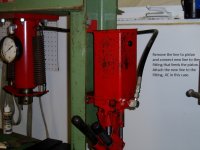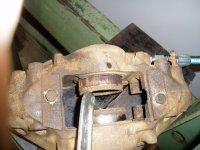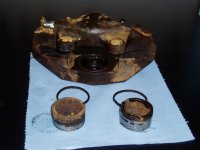Offline
Using my shop press to remove stuck pistons from rusty calipers. I’m sure others have done this with a hydraulic pump but I haven’t seen it anywhere.
I have a few old rusty Type B brake calipers that I trying to rejuvenate. I did few Girling calipers in my youth and found them pretty simple to do. You could usually get the pistons out with compressed air or failing that by stomping on the brakes with the pads out and wood shims in their place. But the calipers were not 60 years old then.
My 60 year old rusty ones are a different story. They were completely stuck. So I tried to think of ways to do it with what I have on hand. A Google search described using everything from a grease gun to a test stand for diesel injectors. The pump on my press seemed a good candidate so I tried to find a fitting that would allow me to run a hydraulic hose from the pump to the caliper. I'd emove the hose from the pump to the piston and replace it with a new hose from the pump to the caliper.
This turned out to be the toughest part of the project but I finally came up with the fitting and I had a hose made (not cheap at $50+) None of my local hydraulic shops could supply the fitting but I did find one on eBay.
Here is is the fitting: 6400-04-03 HYDRAULIC FITTING 1/4" MALE JIC X 3/16" MALE BOSS (Tube O.D. / Hose I.D. Size)
The male JIC fits my press pump and the 3/16 male boss (ORB) fits the caliper. The o-ring seated itself in the slight recess at just before the threads on the caliper (at least it did on mine). Or you could use a copper washer like the original.
Here is the size translation provided by eBay seller “adapters21”:
THREAD SIZES FOR 6400-04-03 HYDRAULIC FITTING 7/16"-20 MALE JIC X 3/8"-24 MALE BOSS. The 3/16 male boss = 3/8 24 and fits the caliper.
Once I had the fittings sorted, the pistons were out in minutes.
I bypassed the pressure gauge so I have no idea how much force it took but the pistons came out easily when I went to high pressure on the two stage pump but I think I could have gotten the low pressure side to do it.
Any hydraulic pump will work as long as you can find a way to tap it. The press was particularly convenient; once I located the correct fitting.
Cheers,
Tom
I have a few old rusty Type B brake calipers that I trying to rejuvenate. I did few Girling calipers in my youth and found them pretty simple to do. You could usually get the pistons out with compressed air or failing that by stomping on the brakes with the pads out and wood shims in their place. But the calipers were not 60 years old then.
My 60 year old rusty ones are a different story. They were completely stuck. So I tried to think of ways to do it with what I have on hand. A Google search described using everything from a grease gun to a test stand for diesel injectors. The pump on my press seemed a good candidate so I tried to find a fitting that would allow me to run a hydraulic hose from the pump to the caliper. I'd emove the hose from the pump to the piston and replace it with a new hose from the pump to the caliper.
This turned out to be the toughest part of the project but I finally came up with the fitting and I had a hose made (not cheap at $50+) None of my local hydraulic shops could supply the fitting but I did find one on eBay.
Here is is the fitting: 6400-04-03 HYDRAULIC FITTING 1/4" MALE JIC X 3/16" MALE BOSS (Tube O.D. / Hose I.D. Size)
The male JIC fits my press pump and the 3/16 male boss (ORB) fits the caliper. The o-ring seated itself in the slight recess at just before the threads on the caliper (at least it did on mine). Or you could use a copper washer like the original.
Here is the size translation provided by eBay seller “adapters21”:
THREAD SIZES FOR 6400-04-03 HYDRAULIC FITTING 7/16"-20 MALE JIC X 3/8"-24 MALE BOSS. The 3/16 male boss = 3/8 24 and fits the caliper.
Once I had the fittings sorted, the pistons were out in minutes.
I bypassed the pressure gauge so I have no idea how much force it took but the pistons came out easily when I went to high pressure on the two stage pump but I think I could have gotten the low pressure side to do it.
Any hydraulic pump will work as long as you can find a way to tap it. The press was particularly convenient; once I located the correct fitting.
Cheers,
Tom

 Hi Guest!
Hi Guest!

 smilie in place of the real @
smilie in place of the real @
 Pretty Please - add it to our Events forum(s) and add to the calendar! >>
Pretty Please - add it to our Events forum(s) and add to the calendar! >> 






